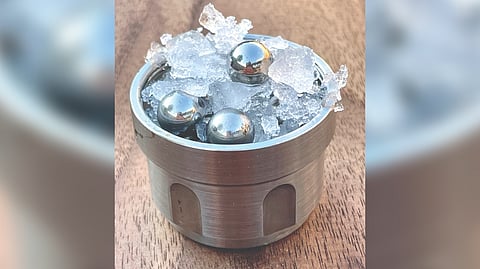

NEW YORK: Shaken and chilled — but not stirred — ordinary frozen water turns into something different: a newly discovered form of ice made of a jumble of molecules with unique properties. “This is completely unexpected and very surprising,” said Christoph Salzmann, a chemistry professor at University College London in England and an author of a paper published on Thursday in the journal Science that described the ice.
Water is a simple molecule that has been intently studied by scientists for centuries: two hydrogen atoms jutting off at a 104.5-degree angle in a V-shape from a central oxygen atom. The new discovery shows, once again, that water, a molecule without which life is not known to be able to exist, is still hiding scientific surprises yet to be revealed. This experiment employed relatively simple, inexpensive equipment to reveal a form of ice that could exist elsewhere in the solar system and throughout the universe.
In day-to-day life, we encounter three forms of water: a vaporous gas like steam, flowing liquid water and hard, slippery ice. The ice of our everyday lives consists of water molecules lined up in a hexagonal pattern, and those hexagonal lattices neatly stack on top of each other. The hexagonal structure is not tightly packed, which is why ice is less dense than liquid water and floats.
With permutations of temperature and pressure outside what generally occurs on Earth, water molecules can be pushed into other crystal structures. Scientists now know of 20 crystalline forms of water. The 20th form of ice was discovered last year.
In addition, researchers also have documented two types of ice with jumbled molecules, what they call amorphous materials. Because one of the amorphous ices is denser than water, it is known as high-density amorphous ice; the other, with a density less than that of water, is low-density amorphous ice.
Amorphous ices are not found on Earth, but they could be prevalent in outer space, in comets, interstellar clouds and icy worlds like Europa, a moon of Jupiter.
There is even a type of water that is both liquid and solid. In 2018, scientists announced the creation of “superionic water,” which was simultaneously solid and liquid.
Dr. Salzmann and his colleagues were not looking to add to the catalog of water ices. They instead wanted to study very tiny ice crystals, because minuscule bits of something sometimes possess properties very different from larger bits of the same stuff. So Alexander Rosu-Finsen, a postdoctoral scientist in Dr. Salzmann’s research group and the lead author of the Science paper, started smashing up ice. The water ice was first chilled in liquid nitrogen to minus 320 degrees Fahrenheit and then placed in a container along with steel balls. A machine then shook the ice and steel balls, still chilled at ultracold temperatures, back and forth at 20 times per second, pulverizing the ice into tiny bits, a process known as ball milling.
“Lo and behold, something completely unexpected happened,” said Dr. Rosu-Finsen. The white material inside looked like what one would expect smashed-up ice to look like, but it had been transformed.
The material was now denser, and much of the crystalline structure had been destroyed, producing an amorphous material. The findings could be of use to planetary scientists. The temperatures fall within what is found on Europa, and Jupiter exerts huge tidal forces on the icy ocean moon, which will be visited and studied closely by NASA and European orbiters.
Visit news.dtnext.in to explore our interactive epaper!
Download the DT Next app for more exciting features!
Click here for iOS
Click here for Android